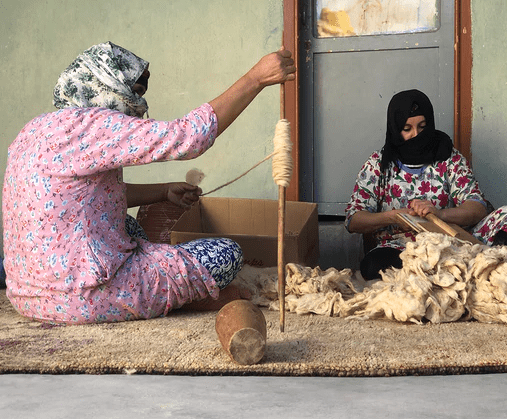
The flagship of Moroccan craftsmanship, the Berber carpet is an art object inseparable from Moroccan culture and decoration. Traditionally handmade, its manufacture is the result of ancestral artisanal know-how passed down from generation to generation.
Warm, comfortable and very graphic with its variety of geometric figures, it dresses all types of interiors thanks to its color palette and varied styles.
Its origins date back to time immemorial. The patterns on the rugs bear similarities to those used in early art from early humans to the Neolithic. It is one of the last vestiges inherited from our most distant ancestors, a tradition dating back thousands of years that has continued through the ages.
The Arabic term “Zarabia” (carpet) means “flower bed” or “that which is stretched on the ground and on which one leans”. The so-called “Berber” carpet, or “tribal” carpet has flourished in rural nomadic communities living mainly from livestock and agriculture in southern Morocco, the Middle and High Atlas where the Berber tribes are most represented. Since the 13th century, when the oldest works preserved today, the production of rugs has experienced a tremendous boom. He is at the center of the economic and daily life of a tribe. It is a precious everyday object with multiple uses: mattress, blanket, bag of beans, decoration … Its sale helps provide for the needs of an entire family, and it still appears today in the trousseau of the young bride. Its sacred character, its long manufacture, and its finesse also make it a luxury gift: very popular in Europe since the Middle Ages, it held a special place among the many precious objects offered to ambassadors or princes as a pledge of political or family alliance. In the 19th century, the Moroccan carpet was one of the most exported products to Europe and this craze has not aged a bit since even today it is acclaimed for its aesthetics and exoticism.
The making of a carpet is an artisanal know-how devolved to women which is passed from mother to daughter according to custom. From shearing to weaving through dyeing, its manufacture follows a very specific ritual of a religious nature. In some regions of Morocco, wool is considered a gift from heaven protecting against the forces of evil according to some local beliefs. Wool is therefore a sacred material which must be worked with care and with the greatest respect.
Even today, weaving in some parts of Morocco occupies a large part of the daily life of many women, however, this work is prohibited on days of prayer, that is, on Fridays and during religious holidays. Sheep shearing is practiced in the spring, there it is the men who shear with scissors and no longer small “imgr” billhooks as in the past and buy the wool fleeces. All of this is a ritual accompanied by prayers to attract divine blessing, the “Baraka”. Collective help and the links of the community known as “tiwizi” are working for the mowing.
Each step of the preparation goes through a slow and painstaking process accompanied by prayers of blessing and ablutions. The wool must be fumigated to be perfectly pure before receiving the dye, made with natural pigments according to traditional recipes, and which must have rested an entire night under the stars to chase away bad spells.
The thread thus prepared, the weaver sets up the loom: two stakes are placed parallel to the sound of a prayer. Then few pieces of sugar are broken between the two stakes before pronouncing this phrase of blessing: “We want to set up the trade, each trade seeing the light of day must be completed” as a promise made to God…


